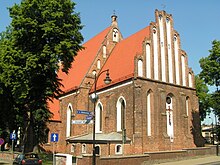コウォ
The town where コウォ (Polish: Koło, [ˈkɔwɔ]) is along Walter River of the central part of Poland. A population of 23,101 people (2006). It is the center of the コウォ county belonging to the ヴィエルコポルスカ prefecture via co-Nin prefecture from 1999.
| コウォ | |||
|---|---|---|---|
| The Gothic church which was built in the 15th century | |||
| |||
| | |||
| A coordinate: 52°12'N 18°38'E / 52.200 degrees N 18.633 degrees E | |||
| Country | |||
| Prefecture | ヴィエルコポルスカ prefecture | ||
| County | コウォ county | ||
| The basic local government | コウォ (the urban local government) | ||
| Construction | The thirteenth century | ||
| The town organization enforcement | 1362 | ||
| Administration | |||
| - The mayor | ミェチスワフ ドロジュジェフスキ | ||
| Area | |||
| - 計 | 13.85km2 (5.3mi2) | ||
| Altitude | 110m (361ft) | ||
| Population (2006) | |||
| - 計 | 23,034 people | ||
| Equal time obi | Central Europe time (UTC +1) | ||
| - Daylight saving time | Central Europe daylight saving time (UTC +2) | ||
| Zip code | It is 62-602 from 62-600 | ||
| Area code | + 48 63 | ||
| Number plate | PKL | ||
| Website | www.kolo.pl | ||
Table of contents
History
コウォ got the right as the town from the Polish King カジミェシュ third in 1362 [1]. There was not the city wall, and two places of gates were only established to be in the safe place close to the Imperial castle built in Nakasu of the Walter River branch. Because it was in the crown land, the town became the center of the crown land as a royal city.
In 1410, a great Polish local noble met in コウォ and discussed it about war with the Teutonic Order (I refer to a fight of グルンヴァルト). In 1452, representatives of the association of Prussia interviewed with the カジミェシュ fourth in an Imperial castle of コウォ (cf. 13 years war).
The great local meeting consisting of Poznan prefecture, カリシュ prefecture, シェラズ prefecture, ウェンチツァ prefecture, ブジェシュチ クヤフスキ prefecture, Ino Wroclaw prefectures of Poland was held in コウォ from the 15th century to 1716.
The town developed as a center of the local trade and manual industry particularly metal industry and the textile business. When it was the 16th century, ズドゥニ district of the Walter River right bank grew up by the Sue work and became the separate towns in 1559. コウォ caught an army (1622) of リソフスキ and 2 degrees (1655) destruction in Sweden and was barely enough to improve as for the economy of the end of 17th century.
Until 1793, コウォ belonged to the カリシュ prefecture co-Nin county. It was occupied from 1793 through 1806 by the Kingdom of Prussia, but I was freed by a revolt of コシュツィウシュコ of 1794 temporarily by a rebel army. In the Warsaw dukedom, I was ruled afterwards from 1807 through 1815 by the Polish constitutionalism kingdom.
Taxation to a Jew
The contract about the Jewish position that lived in コウォ in 1571 was entered into. Thereafter, for the reward that the citizen of the Christian protects a Jew, the Jew will put tax in the city every year in particular [2].
In 1729, in the Jewish community, the payment of 150 pieces of gold coins was required as annual capitation tax, but this amount of money was raised to 300 pieces of gold coins in 1738 [2].
The Polish assembly imposed new special tax to need the official seal of the city every one book of Hebrew and Yiddish in 1775. Heavy punishment was set of the owner of the book that an official seal was not pushed, but many non-printed books circulated by a darkness route [2].
近現代
In the early 20th century, the Jewish number of コウォ reached nearly half of total population. Nazis Germany arrived at コウォ on September 18, 1939. On September 19, all Jewish men 14 years or older were sent to the concentration camp. Fire was hit in a synagogue on the next day [3]. Other Jews are shut up in the ghetto in December, 1940; light; was swept away in December, 1941 that came [4]. The person who stayed was sent to the ヘウムノ Concentration Camp and therefore I died of shooting and gas poisoning and was buried in the very large graveyard. Because was the way station that transferred a Jew to ウッチ, the executive of the Nazis such as Heinrich Himmler visited the town, too [2]; [5].
Sports
- Part 5 in the Olympia コウォ - footballing nation. I belonged to three copies of country from 1963 through 1965 with 1960
Person of the connection
- フランツィシェク クサヴェリ ドモホフスキ - novelist, poet, translator, publisher, critic, satirist
- Tomasz Koss - footballer. I belong to FC Erzgebirge Aue
- Jan プスティ - hurdler
- Specialist in alone brand - infant circulatory organ department
Sister city
Footnote
- ^ "Koło" - Encyclopedia of Jewish Communities in Poland, Volume I
- ^ a b c d Mahler, Rafael. "From the near and far past". Some information about the history of the Jews of Koło.
- ^ Dates of grief. Sefer Koło; Funfhundert yor Yiddish Kolo. 1958. Mordekhai Halter (ed.) p. 335.
- ^ International Jewish Cemetery Project
- ^ Kolo (Muhlental), Poland
Outside link
This article is taken from the Japanese Wikipedia コウォ
This article is distributed by cc-by-sa or GFDL license in accordance with the provisions of Wikipedia.
In addition, Tranpedia is simply not responsible for any show is only by translating the writings of foreign licenses that are compatible with CC-BY-SA license information.




0 개의 댓글:
댓글 쓰기